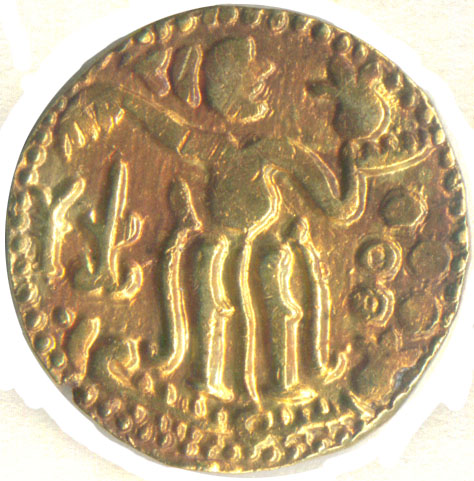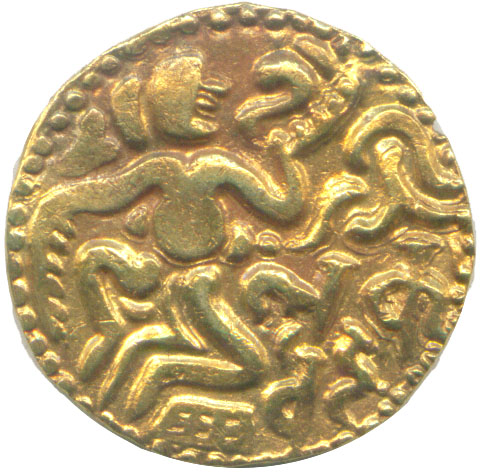Lanka : Modern Replica
Gold Type III Kahavanu - Jasmine & Chank
The anonymous gold Type III Kahavanu known as Jasmine flower and
Chank. Codrington Kahavanu Type III B. This specimen with a very low
Silver percentage is probably modern replica and not from medieval era.
| SPECIFICATIONS |
| Denomination | One Kahavanu |
| Metal | Gold 0.52 |
| Alloy | Ag%Cu = 0.09 |
| Type | Struck |
| Diameter | 19.6 mm |
| Thickness | 1.8 mm |
| Weight Std. | 4.53 gms |
| Weight | 4.27 gms |
| Die-Axis | 45° |
|

| 
|
| Codrington 53; OMRS-70; Mitchiner #825
|
Obverse : Standing figure Kuvera with head to right. Crown
thick straight line with triangle in rear. In a Dhoti
(garment) indicated by two curved lines on either side and one line in
between longer than legs, standing on a lotus plant stalk with small
circle in centre ending on left in a chank and on right
in Jasmin flower as in hand. In left hand is an
open Jasmine flower (pichcha mala) viewed from side.
The right arm is extended with hand over a symbol (1b) consisting of a
straight shaft with short cross pieces, ending in four prongs, which
are thick. The head of the symbol is somewhat like the calices of two
half-opened flowers, one being placed above the other. To right five
annulet with dot in center (Target). A beaded circle along the
periphery of the coin.
Reverse :A figure Bahirava, head right crown as on obverse
Squatting upon asana, (a bed-like throne) represented by a
short rectangular frame, divided lengthwise by a line and two cross
lines (6 compartments). dhoti represented by bent line
and small line in angle between the legs. The right arm is pendent
over the right knee, which is drawn up; In left hand in front of the
face a chank. In field to right, Nagari legend in three lines :
| 1 | 2 3 | 4 5 | The anusvara over La.
|
| Sri | Lanka | Vibhu
Vibhu is a title of Vishnu.
|
A beaded circle along the periphery of coin.
The Base gold kahavanu once fairly common in Madura District,
in South India, appear to be all of type III B. (Jasmin & Chank)
They probably were current for several centuries, up to the modern era.
The Kahavanu was scanned at 600dpi and displayed at 300dpi.
Coin was purchased in 1998 June from an antique shop in Kandy, Sri Lanka,
when I did not understand much about medieval gold Kahavanu.



